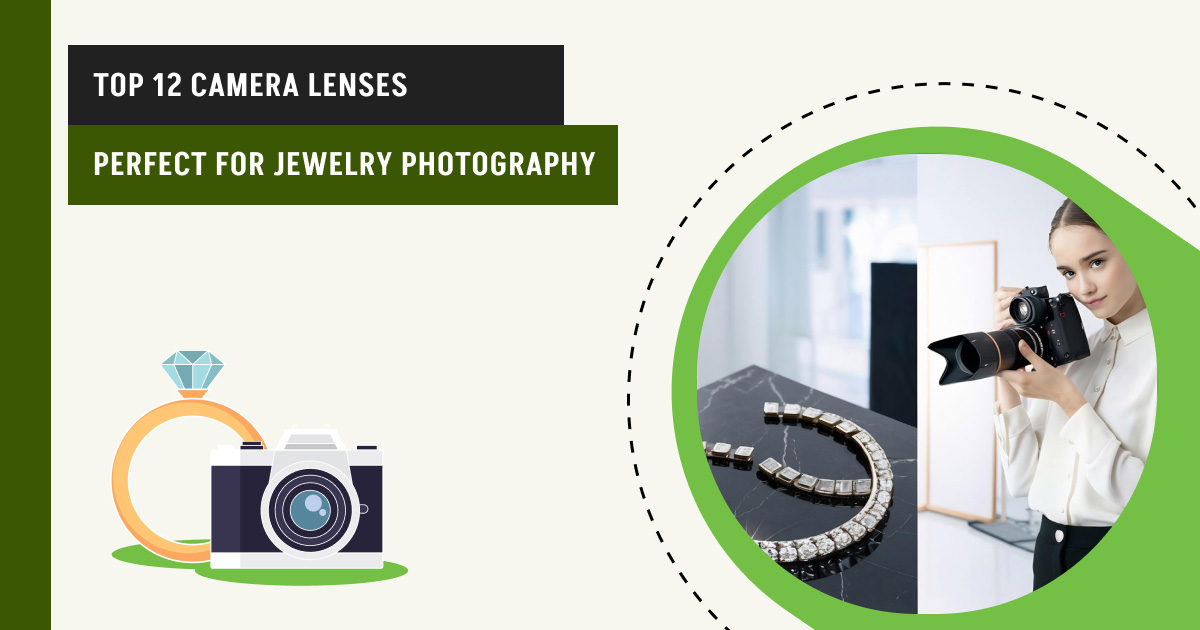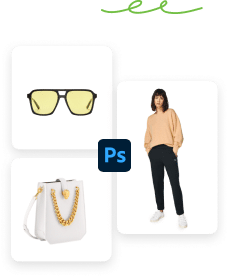Choosing the right camera lens is essential for capturing jewelry photos that highlight every sparkle, texture, and detail. In 2025, photographers rely mostly on macro lenses but also use zoom and tilt-shift lenses depending on the shot. Each lens offers unique features to suit different shooting needs, budgets, and creative preferences.
Here are the 12 best camera lenses for jewelry photography in 2025, along with what makes each one special:
1. Canon EF 180mm f/3.5L Macro USM: A favorite among professionals, this lens offers superb sharpness and allows you to capture extremely close details with beautiful background blur, making jewelry shine.
2. Canon EF 50mm f/1.8 STM:
Known as the “nifty fifty,” this affordable lens provides great image quality with a wide aperture to create a smooth bokeh, ideal for subtle product shots.
3. Canon EF 100mm f/2.8 Macro USM Lens: Perfect for detailed shots, this lens delivers excellent focus accuracy and sharpness, especially useful for small jewelry pieces.
4. Sigma 70mm f/2.8 DG Macro Art: Renowned for its versatility, this lens combines sharpness and color accuracy, making it a great choice for professional jewelry photography.
5. Sony FE 50mm f/2.8 Macro: A compact and lightweight lens for Sony mirrorless cameras, it offers close-up shooting capabilities with precise focus control.
6. Sony FE 70-200mm f/2.8: Though a zoom lens, its wide aperture and focal length range make it flexible for both close-up and wider product shots, helping isolate the jewelry from the background.
7. Sony SEL90M28G FE 90mm f/2.8-22: Highly praised for its macro sharpness and smooth bokeh, this lens lets you capture stunning details with ease.
8. Tamron SP 90mm f/2.8 Di VC USD Macro: This lens combines vibration compensation with macro capabilities, allowing sharp images even handheld — perfect for intricate jewelry.
9. Nikon AF-S DX Micro Nikkor 85mm f/3.5G: A reliable macro lens for Nikon users, offering excellent sharpness and natural color reproduction.
10. Nikon AF-S VR Micro-NIKKOR 105mm f/2.8G: Equipped with vibration reduction, this lens is ideal for close-ups with crystal-clear focus and minimized blur.
11. Canon TS-E 135mm f/4L: A tilt-shift lens that provides creative control over focus plane, enabling unique and sharp product photos with controlled perspective.
12. Canon 60mm f/2.8 Macro: Compact and versatile, this lens is great for detailed shots with accurate color and sharpness, popular among product photographers.
What you’ll learn in this article
- 1 1. Canon EF 180mm f/3.5L Macro USM
- 2 2. Canon EF 50mm f/1.8 STM
- 3 3. Canon EF 100mm f/2.8 Macro USM Lens
- 4 4. Sigma 70mm f/2.8 DG Macro Art
- 5 5. Sony FE 50mm f/2.8 Macro
- 6 6. Sony FE 70-200mm f/2.8
- 7 7. Sony SEL90M28G FE 90mm f/2.8-22
- 8 8. Tamron SP 90mm f/2.8 Di VC USD Macro
- 9 9. Nikon AF-S DX Micro Nikkor 85mm f/3.5G
- 10 10. Nikon AF-S VR Micro-NIKKOR 105mm f/2.8G
- 11 11. Canon TS-E 135mm f/4L
- 12 12. Canon 60mm f/2.8 Macro
- 13 Which Type of Lens is Best for Jewelry Photography?
- 14 Why Does Choosing the Best Camera Lens for Jewelry Photography Matter?
- 15 What are the Things to Consider While Buying the Best Camera Lens for Jewelry Photography?
1. Canon EF 180mm f/3.5L Macro USM
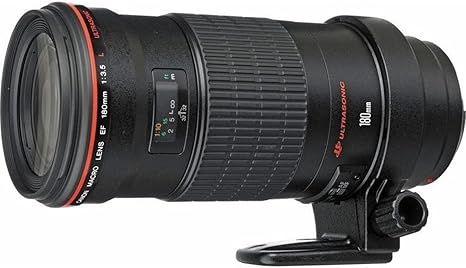
The EF 180mm f/3.5L Macro USM AutoFocus Telephoto Lens is one of the longest macro lenses Canon has produced. Like other L-series lenses, it is compatible with a full-frame or Canon APS-C camera. Used on an APS-C DSLR, it gives a 288mm equivalent field of view in full format. Inside the lens, the floating system is used for better close focus. Also, due to the IF design, the length doesn’t change while focusing. The silent ring-type USM, known for fast AF (autofocus), works somewhat differently in this lens. Setting the autofocus on one shot, the full-time manual focus works. This lens can produce maximum magnification from afar. As a result, there’s more depth of the field with nice blurring in the background. It produces nice color contrasts and a bokeh effect.
Specifications
- Lens type: Telephoto
- Compatible mountings: Canon EF
- Dimension: 7.36 x 3.27 x 3.27 inches
- Weight: 2.4 pounds
- Construction: 14 elements in 12 groups
- Angle of view: 13 degrees
- Magnification Ratio: 1:1
| Pros | Cons |
| Well built & sturdy | Long & heavy |
| Sharp & detailed image | Lacks image stabilization |
| Wonderful color contrast |
2. Canon EF 50mm f/1.8 STM

Canon EF 50mm f/1.8 STM is a compact prime lens. Compatible with Canon EF-mount cameras, full-frame and APS-C bodies. The lens’s optical design includes optimized coatings to reduce flare and ghosting. It has a metal mount that increases durability. The 7-blade diaphragm offers smooth bokeh for creative jewelry photography. The lens uses an STM (Stepping Motor) for quiet, accurate autofocus.
Specifications
- Lens type: Standard
- Compatible mountings: Canon EF
- Dimension: 1.54 x 2.72 x 2.72 inches
- Weight: 5.6 ounces
- Construction: 6 elements in 5 groups
- Angle of view: 40º, 27º,46º
- Magnification ratio: 0.21x
| Pros | Cons |
| Affordable and lightweight | No image stabilization |
| Autofocus accuracy and consistency | Autofocus may malfunction in low light. |
| Metal mount |
3. Canon EF 100mm f/2.8 Macro USM Lens

The EF 100mm f/2.8 Macro USM fixed lens is Canon’s entry-level full-frame macro lens. It is compatible with APS-C and full-frame digital cameras. Mounted with APS-C, this 100mm field of view offers 160mm. It is popular due to the spectacular quality of images, great focal length, and narrow depth of field. The quiet-sounding USM inside offers unmatched autofocusing speed from any distance. It offers sharpness at f/16, where diffraction has been limited. This lens has a full-time manual focusing even in the autofocus mode, and this is extremely accurate. It offers sharp image quality with no chromatic aberration, and the bokeh around the subject is pretty smooth.
Specifications
- Lens type: Telephoto
- Compatible mountings: Canon EF
- Dimension: 2.99 x 2.13 x 2.13 inches
- Weight: 1.32 pounds
- Construction: 12 elements in 8 groups
- Angle of view: 24 degrees
- Magnification Ratio: 1:1
| Pros | Cons |
| Offers excellent image quality | No image stabilization |
| Fast and quiet autofocusing | |
| Chromatic aberrations are in check |
4. Sigma 70mm f/2.8 DG Macro Art
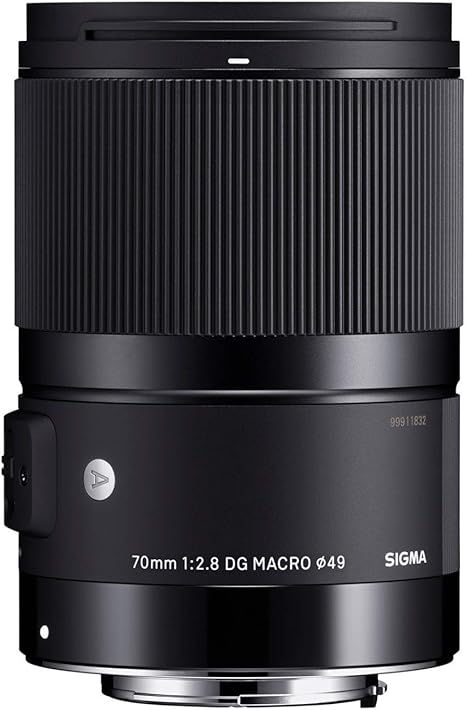
Sigma 70mm f/2.8 DG Macro Art is a full-frame macro lens, compatible with multiple mounts including Sony E and Canon EF. Designed for exceptional optical performance, the lens features a sturdy build and delivers 1:1 life-size magnification. Its advanced optical formula with SLD and FLD glass elements minimizes aberrations and maximizes sharpness. The lens ensures a precise, quiet focus-by-wire system. The Multi-Layer Coating reduces flare and ghosting, while the rounded 9-blade diaphragm ensures pleasing bokeh—the perfect lens for shooting jewelry in controlled environments.
Specifications
- Lens type: Macro
- Compatible mountings: Sony FE, Sony E
- Dimension: 4.2 x 2.8 x 2.8 inches
- Weight: 1.1 pounds
- Construction: 13 elements in 10 groups
- Angle of view: 34.3
- Magnification ratio: 1:1
| Pros | Cons |
| Offer art series quality photos | Lack of weather sealing |
| Outstanding optical performance | |
| High-quality color fidelity and contrast |
5. Sony FE 50mm f/2.8 Macro
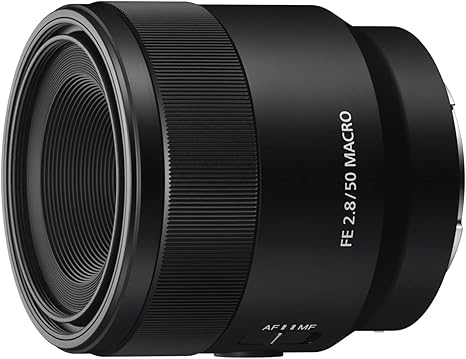
The SEL50M28 FE 50mm F2.8 Full Frame E-mount Lens is compatible with Sony FE format full-frame sensor cameras and APS-C cameras. When mounted on the latter one, the 35mm offers a 75mm equivalent. This lens is easily portable; hence, it’s good gear for taking macro shots in any environment. It doesn’t include an aperture ring; rather, it has a turnable electronic focus ring. It offers to take sharp images even at full aperture. Like Sony’s other camera lenses, this lens also includes in-camera chromatic aberration correction for JPEG and raw files. Though it does not have a lens hood, the lens offers a well-controlled flare. Image shots come with dynamic & natural colors.
Specifications
- Lens type: Macro
- Compatible mountings: Sony FE
- Dimension: 4.09 x 3.43 x 4.69 inches
- Weight: 12 ounces
- Construction: 8 elements in 7 groups
- Angle of view: 47 degrees
- Magnification Ratio: 1:1
| Pros | Cons |
| Compact & lightweight | Slow & noisy autofocusing |
| Performs in low light | |
| Dust & moisture sealed |
6. Sony FE 70-200mm f/2.8

The Sony FE 70-200mm f/2.8 GM OSS Lens is a full-frame camera lens. It is compatible with any Sony E-mount camera, crop-sensor, and full-frame camera. The macro capability of this lens allows for taking close and sharp images. At the close focusing distance, it makes the subject’s texture completely exposed with the highest magnification. This lens has a fast zooming and focusing capability. The ultrasonic ring-type motor and the dual linear stepping motor ensure precise and fast AF. The manual focus performs fantastically as well. It is connected with optics and responds to commands instantly.
Specifications
- Lens type: Telephoto
- Compatible mountings: Sony FE
- Dimension: 11.93 x 5.47 x 5.67 inches
- Weight: 4.91 pounds
- Construction: 23 elements in 18 groups
- Angle of view: 34-12.5 degrees
- Magnification Ratio: 1:4
| Pros | Cons |
| Delivers sharp images | 2-stop optical stabilization |
| Noiseless autofocusing | |
| Protection from fingerprints | |
| Resistant to dust & moisture |
7. Sony SEL90M28G FE 90mm f/2.8-22

Sony is a great choice to capture some brilliant shots with fine details. It is compatible with full-frame mirrorless cameras. This 90mm lens offers 135mm equivalent when mounted on an APS-C camera. It is capable of focusing fast when toggled between manual focus and autofocus. The nano AR coating subdues reflection, ghosting & flare. This lens has fast autofocusing. Setting a time limit on the focusing range saves time while shooting. The filter threat resides firmly in the front section of the lens. So, the lens doesn’t rotate, which is advantageous for polarizing filters.
Specifications
- Lens type: Telephoto
- Compatible mountings: Sony E
- Dimension: 5.16 x 3.11 x 3.11 inches
- Weight: 1.33 pounds
- Construction: 15 elements in 11 groups
- Angle of view: 27 degrees (35 mm) and 17 degrees (APS-C)
- Magnification Ratio: 1.0x
| Pros | Cons |
| Quiet and sharp focus | Aperture limitation |
| Allows image stabilization | |
| Ghosting & flare reduction | |
| Resistant to dust & moisture |
8. Tamron SP 90mm f/2.8 Di VC USD Macro

Tamron SP 90mm f/2.8 Di VC USD Macro is a full-frame macro lens, mounted on Canon EF, Nikon F, and Sony A mounts. The lens has built-in features Vibration Compensation (VC) image stabilization. The lens achieves true 1:1 magnification. Its robust, moisture-resistant build makes the lens a perfect fit for outdoor shooting. The LD and XLD elements’ optical design minimizes aberrations. With eBAND coating, the lens reduces flare and ghosting in the photo. The USD (Ultrasonic Silent Drive) motor offers quick, quiet autofocus for precise photo creation.
Specifications
- Lens type: Macro
- Compatible mountings: Canon EF
- Dimension: 4.6 x 4.5 x 4.5 inches
- Weight: 1.4 pounds
- Construction: 14 elements in 11 groups
- Angle of view: 27° 2′ on full-frame cameras
- Magnification ratio: 1:1
| Pros | Cons |
| Lightweight and compact | Autofocus slows when shooting at close distances |
| Fast and accurate autofocus | |
| Weather-sealing attribute | |
| Offer a lens hood |
9. Nikon AF-S DX Micro Nikkor 85mm f/3.5G
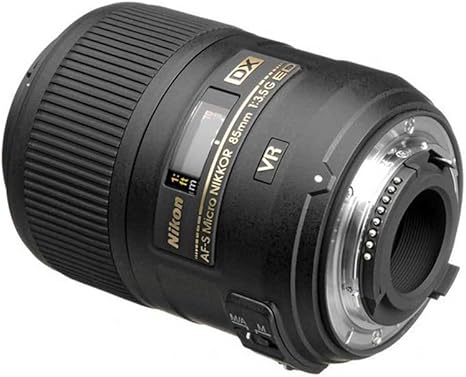
Nikon made the AF-S DX Micro NIKKOR 85mm f/3.5G ED VR lens specifically for DX cameras. But it is compatible with any entry-level camera body having no focus motor. Mounted with a DX-camera body, this 85mm offers equivalent to 128mm on a full-frame sensor. It allows pretty close shots with stunning sharpness, required for jewelry. It ensures smooth focus in both manual and auto-focus modes. The SWM inside ensures quiet autofocus. The lens has a rubber gasket to prevent dust from penetrating the camera. The ED glass ensures sharpness and resists chromatic aberration. The lens shows slight distortion in the corners that is correctable with Jewelry photo post-production.
Specifications
- Lens type: Telephoto
- Compatible mountings: Nikon F (DX)
- Dimension: 3.9 x 2.87 x 2.87 inches
- Weight: 12.5 ounces
- Construction: 14 elements in 10 groups
- Angle of view: 18° 50’
- Maximum Reproduction Ratio: 1.0x
| Pros | Cons |
| Compact and portable weight | User reported clarity issues |
| Has an image stabilization system | |
| Offers sharpness at optimum apertures |
10. Nikon AF-S VR Micro-NIKKOR 105mm f/2.8G

Nikon AF-S VR Micro-NIKKOR 105mm f/2.8G IF-ED Lens is considered the world’s first macro lens built together with VR and SWM (Silent Wave Motor). This lens is compatible with Nikon digital SLR cameras (full-frame and APS-C) and Nikon Z series cameras. It is a full-frame prime lens and has a solid metallic build. This lens has speedy, precise & extremely quiet autofocusing and switches fast between autofocus and manual focus. It is of metal build. The inside Nano Crystal Coat reduces flare and internal reflection. There is one ED glass element that helps eliminate chromatic aberration. Also, the VR II technology minimizes camera shake by offering 4 stops equivalent shutter speed.
Specifications
- Lens type: Telephoto
- Compatible mountings: Nikon F (FX)
- Dimension: 4.57 x 3.27 x 3.27 inches
- Weight: 1.74 pounds
- Construction: 14 elements in 12 groups
- Angle of view: 23°20′
- Maximum Reproduction Ratio: 1.0x
| Pros | Cons |
| Quick & quiet auto-focus | Fixed focal length, not zoomable |
| Captures fine details sharply | Autofocus may malfunction in low light. |
| Takes high-quality distant shots | |
| Produces high-resolution & high contrast images |
11. Canon TS-E 135mm f/4L

Canon’s L-series tilt shift lens TS-E 135 mm f/4L offers precise control for taking tabletop jewelry shots. The L-series is already popular due to optical clarity and sharp images. The lens’ tilt function manipulates focus to capture design intricacy with depth, whereas the shift function corrects perspective. Its f/4.5.6 maximum aperture will ensure clear, sharp, and professional images even in low-light photography.
Specifications
- Lens type: Tilt Shift, Macro
- Compatible mountings: Canon EF-S
- Dimension: 27.8 x 15.4 x 15.1 cm
- Weight: 2.46 kg
- Construction: 11 elements in 7 groups
- Angle of view: 18° 00
- Maximum Reproduction Ratio: 1:2
| Pros | Cons |
| Allows controlling | Steep learning curve |
| Perspective and depth of field | Not budget-friendly |
| Precise reflection management | |
| No chromatic aberration |
12. Canon 60mm f/2.8 Macro
The Canon EF-S 60mm f/2.8 Macro Lens is compatible with APS-C EOS DSLR cameras. When mounted on a 35mm camera, this 60mm lens offers a 96mm angle of view. The lens’s sharpness remains high in any aperture setting. It allows full-time manual focusing with the length remaining constant. Amidst both autofocus and manual focus, it is best to shoot jewelry manually to capture distortion-free details.
Specifications
- Lens type: Telephoto
- Compatible mountings: Canon EF-S
- Dimension: 2.76 x 2.87 x 2.87 inches
- Weight: 11.8 ounces
- Construction: 12 elements in 8 groups
- Angle of view: 25 degrees
- Maximum Reproduction Ratio: 1:1
| Pros | Cons |
| Small, durable & light-weight | Low light hinders the autofocus from understanding the subject. |
| Low distortion and controlled chromatic aberration | |
| Speedy autofocus | |
Which Type of Lens is Best for Jewelry Photography?
The best type of lens for jewelry photography is the macro lens for taking close and sharp images of jewelry’s intricate design. Other lenses for shooting jewelry include a prime lens, a zoom lens, and a tilt/shift lens.
- Macro Lens
The macro lens is essential for taking jewelry photographs as it offers close-focused shots of the objects’ craftsmanship and fine texture. The 1:1 magnification ratio of the macro lens reproduces tiny objects that appear life-size or bigger with precision. Users get a good view of gemstones, designs, engravings, and facets in the jewelry items.
- Prime Lens
A prime lens has a fixed focal length and is used for taking standard images from a fixed distance. Every prime lens offers a single focal length shown with a number in millimeters or mm—a smaller number captures a wider area, and a larger number provides a more focused perspective. The prime lens lacks a zooming feature, so photographers physically move to adjust it for the right framing. Being small in size and light-weight, a prime lens is a perfect choice for outdoor product photography.
- Zoom Lens
A zoom lens offers different focal lengths within a single lens. Photographers need to rotate the zoom ring and be able to adjust the composition. This flexibility is effective for jewelry shooting when frequent shooting from different perspectives is needed without attaching or detaching the lenses.
- Tilt Shift Lens
The tilt shift lens, also called the perspective control lens, changes the position, aligning the camera’s image sensor. Tilting allows for the sharpening of multiple surfaces of jewelry, making the intricate design appear detailed. Shifting allows reframing the jewelry, avoiding distortion and ensuring the right proportion and composition. It offers high-level technical control for precision and flexible product photography.
Is a 50mm Lens Good for Jewelry Photography?
50mm is a prime lens and is obviously a good lens for jewelry product photo shoots, thanks to its low light adaptability and super sharp & high-quality images.
Do Jewelry Photographers Need Macro Lenses?
Jewelry photographers need macro lenses the most to take close shots. A macro lens isn’t a must for jewelry photography. But this lens is good for capturing shots of tiny jewels or showing jewelry details.
What is the Best Focal Length for Jewelry Photography?
The best focal length for jewelry photography is a 105mm lens, as it allows for maintaining a comfortable working distance from the subject, offers minimal distortion, and isolates the subject from the background.
Why Does Choosing the Best Camera Lens for Jewelry Photography Matter?
Choosing the best camera lens for jewelry photography matters for taking high-quality pictures of jewelry products. An efficient camera lens produces a professional-grade camera regardless of the camera. Other reasons to choose the best camera lens for jewelry are as follows.
- Lens quality impacts the product’s look, appearance, and quality.
- Professional-grade lenses offer diverse control over focus, contrast, details, background, etc.
- High-quality lenses allow photographers to take artistic shots of jewelry even in low light.
- Choosing a feature-rich lens contributes to a photo’s sharpness and color contrast, thus improving creative perspective.
- A quality lens controls the recurrence of chromatic aberration, camera shake, distortion, etc.
What are the Things to Consider While Buying the Best Camera Lens for Jewelry Photography?
Features to consider while buying the best camera lens for jewelry photography are compatibility, macro mode, focal length, magnification ratio, image stabilization, focusing, build quality, and price. Serving a wide range of clientele will require you to upgrade your lens collection.
1. Compatibility
Lens compatibility is mostly written in the lens manufacturer’s guidelines. Camera mounting type, sensor size (full-frame, APS-C), etc, should match the camera to get optimal output.
2. Focal Length
A small focal length provides a better view. The widely recommended focal length for shooting jewelry is 105mm. Choose a prime lens for a fixed focal length or a zoom lens for an adjustable focal length, depending on your purposes. High focal lengths take jewelry shots of high quality at life-like size.
3. Magnification Ratio
Magnification ratio, also known as the reproduction ratio, offers a good close view. Modern camera lenses offer ratios beyond 5:1, revealing intricate details, materials, and textures to capture e-commerce-style product photos.
4. Image Stabilization
Camera lens’ built-in image stabilization (IS) or vibration reduction (VR) technology is a powerful feature that ensures still & sharp shots. Tremors, rough weather, or motion blur cause camera shake, resulting in blurry photos. The IS or VR feature eliminates the shakes, creating steady pictures.
5. Focusing
Check the lens’s focus capability. Manual focus offers precision. Nowadays, the autofocus has improved and offers accuracy with speedy focusing. Check the focus controlling capabilities of your preferred lens.
6. Build Quality
Learn the build quality of the lens. Feature-rich lenses are quite heavy, but lightweight cameras also produce quality images and offer portability for outdoor shooting. Having a good-quality photography tripod will support the camera lens well. A well-built camera lens has a sturdy build and weather-sealing capability.
7. Price
Camera lens price impacts the type of lens you’ll buy. Many pro-grade product photographers tend to purchase pricey lenses due to efficiency, compatibility & longevity. Getting a pre-owned one can be a better option if you aim for a high-quality one as a new photographer.
How Do You Avoid Reflections in Jewelry Photography?
There are 2 ways to avoid reflection in jewelry photoshoots: a. During shooting, place opaque papers or pieces of cloth at the bottom, as the background, of jewelry. After shooting, remove the reflection through photo editing later on.
